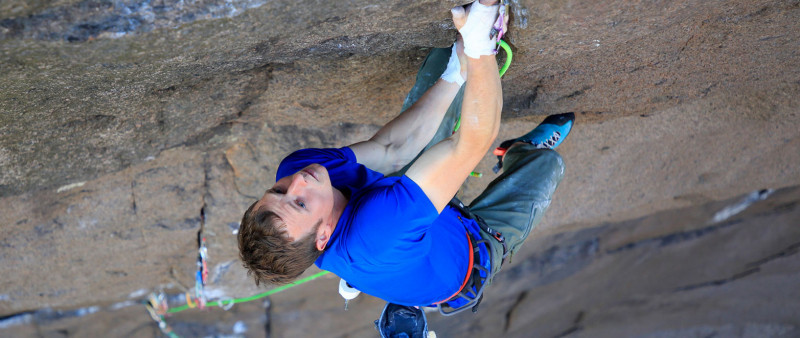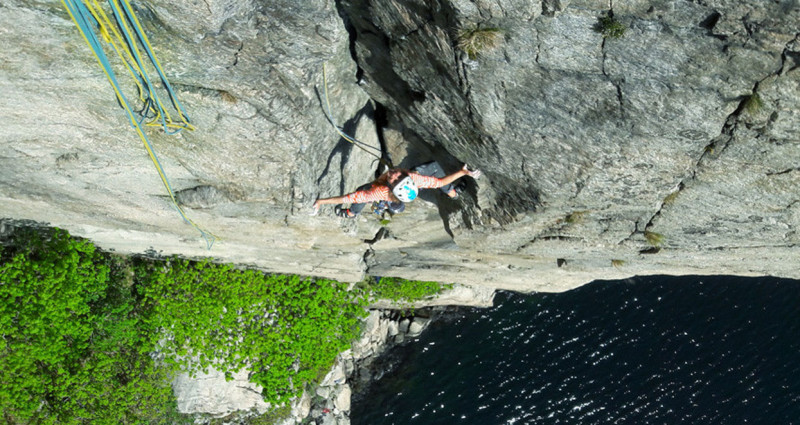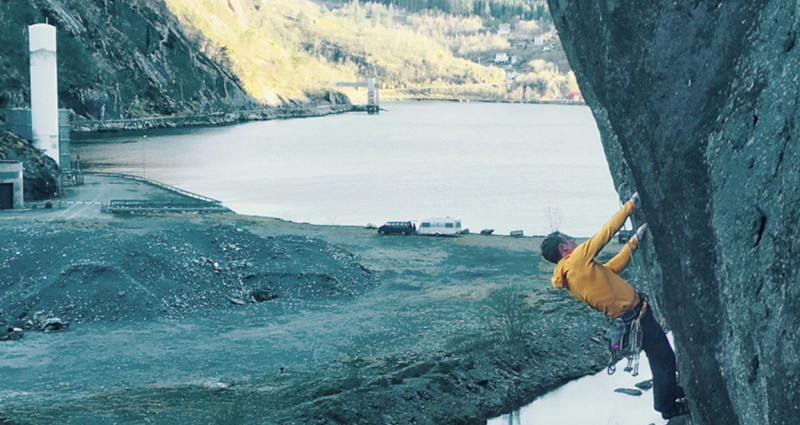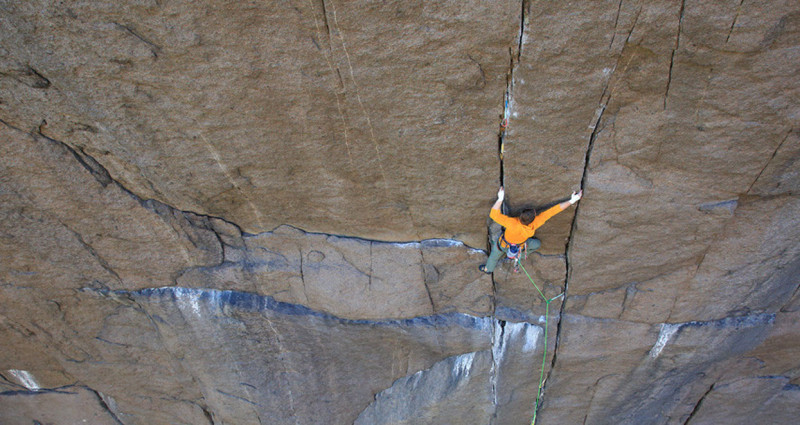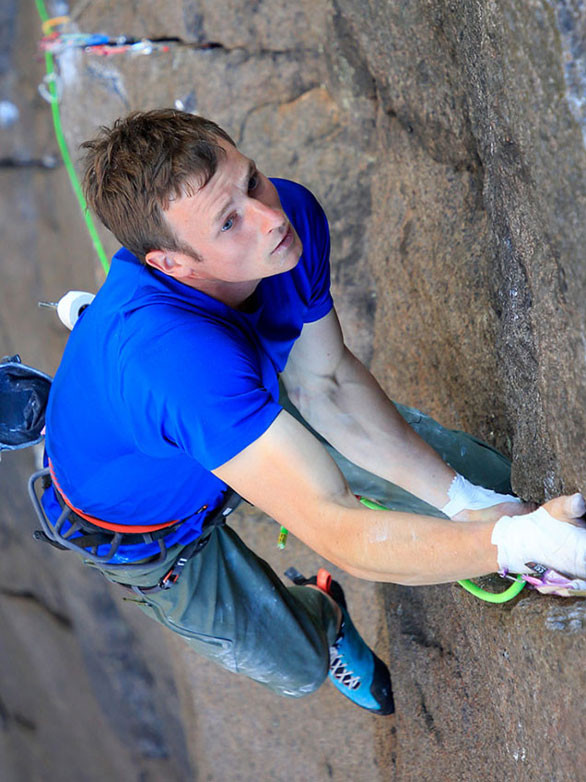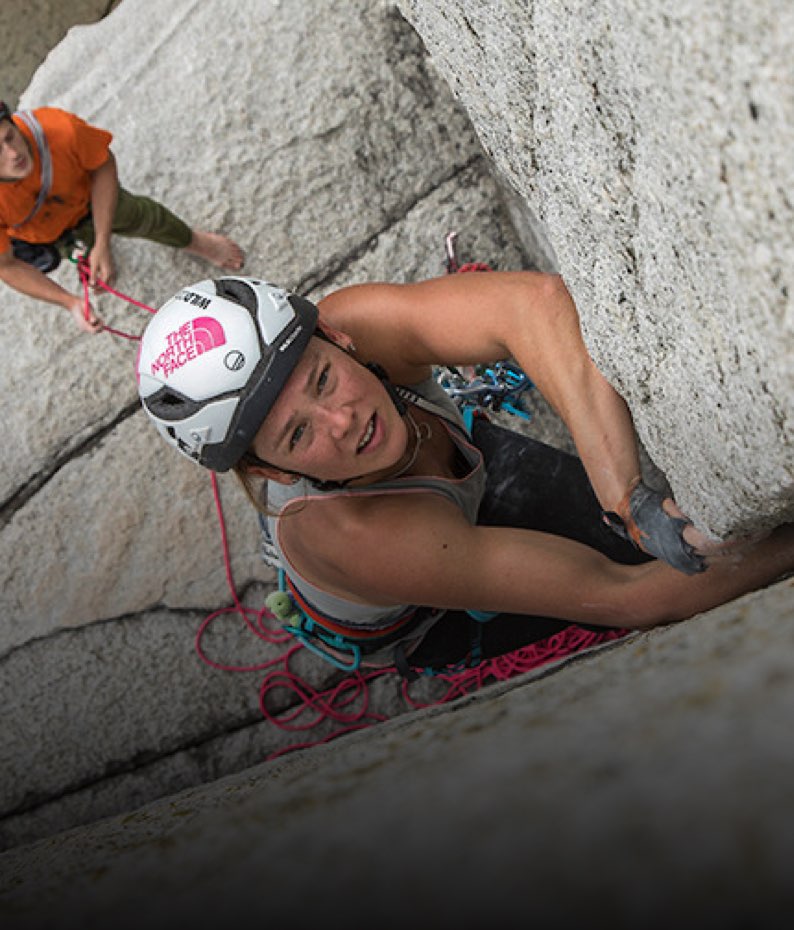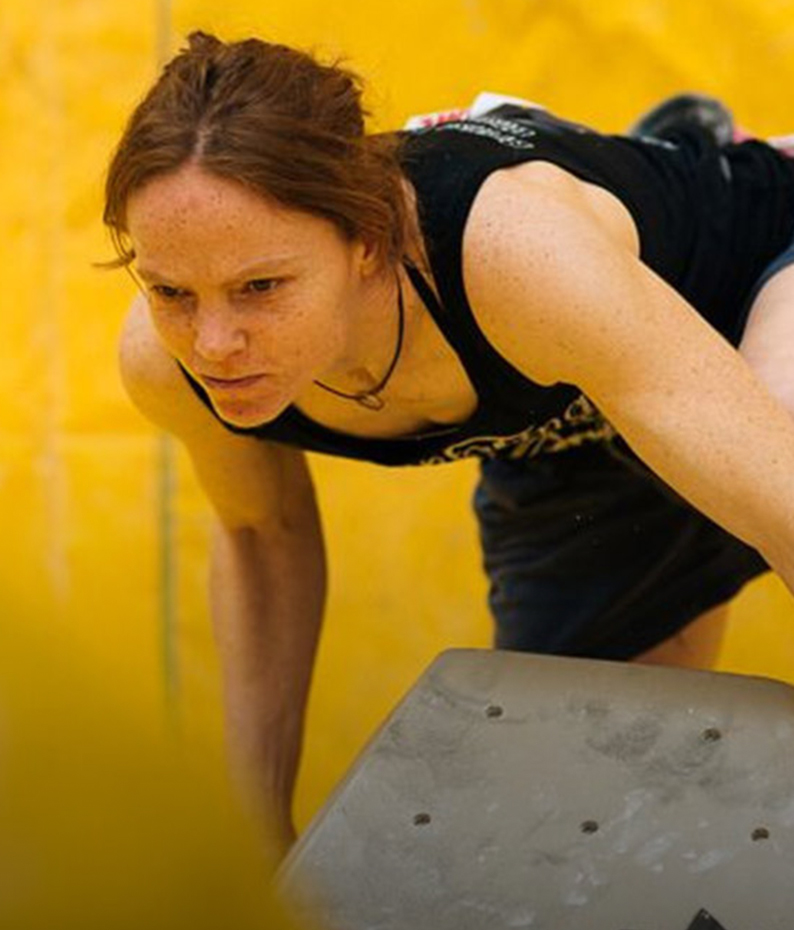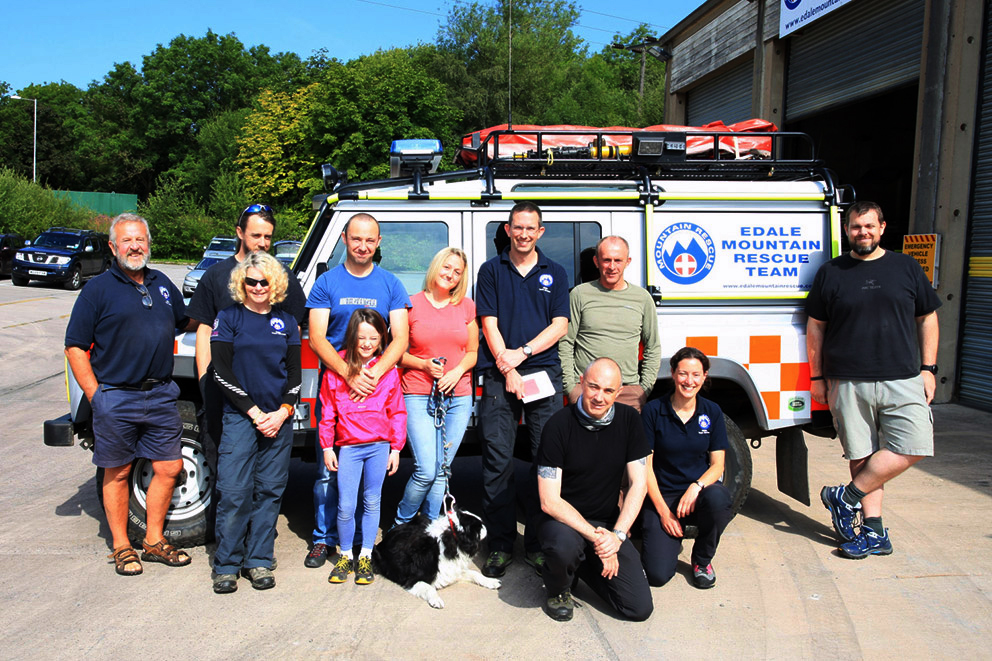A Summer Saga with Pete Whittaker
A Pasty Brit, Canoes, and Virgin Buttresses
Being the pasty white Brit that I am, I felt like wilted spinach searing in the sun. But, pulling hard in the frictionless heat wasn’t going to stop the exploration of new routes, and endless adventure. After spending a total of 10 weeks on two different trips climbing across Norway, putting up new routes and searching out virgin walls by canoe with my girlfriend Mari, I’m psyched for my next opportunity to head back.
A trip full of sunshine is not exactly what people think of when you say you’re going to Norway to climb. It’s certainly not what I anticipated either as I packed my wooly socks and down jacket. I think most people associate Norway climbing with rain and bushwhacking, but there was hardly any of either.
Chapter 1 - Ca-New Routing
Ca-new routing = canoeing to walls and questing from the boat. It’s a way of climbing walls that come straight out of the ocean, but without the glamour of having a yacht or speedboat, like they do in those deep water solo movies with Sharma and stuff. It just really simplifies things and making it a bit harder work, which makes it all the more gratifying.
Ca-new routing launched full swing once I arrived in the Rogland region, an area on the South West tip of Norway. Upon arrival, it became apparent that there was an abundance of new stuff to be done. Driving around the Valleys I’d point out different lines on numerous crags, “has that been done?…..ooooo has that one been done?….what about that?” the answer always seemed to be ‘no’.
In the end, I stopped pointing out specific lines and just decided to ask if whole multi-pitch buttresses had any routes on them at all. Surprisingly the answer was still usually ‘no’.
In a region with such an abundance of unclimbed rock, I mean lots and lots of unclimbed rock, I felt a bit stupid thinking back to all the time I had spent scrapping around in the Peak District seeking out untouched holds. Now I was in on the secret of Rogaland, and I could see line after line of potential FA’s.
My favorite two have to be Norwegian Crown and Conquest from the West.
Conquest from the West was found on a ca-new routing mission. Mari and I made a short journey across Lysefjord, picked the most obvious line and ventured upwards. The climbing wasn’t straight from the Canoe, so we beached the boat, took a couple of steps to the base and smashed on up a two pitch classic. After a few obligatory rock trundles, it cleaned up to be a great route and we ebbed back down to the canoe and made a speedy paddle across the Fjord to ensure we didn’t get mown down by the evening ferry. This would be a fun route for someone looking for a low-stress adventure.
In the same region (although not requiring a water approach) I was inspired by a line on the left side of The Profile Wall.
"This is one of those routes of myths,
highly mentioned but barely ever tried (I think maybe only two other parties have been up there). All the lines on the Profile Wall are mega lines but this one, in particular, stood out to me. ‘The Bo’ feature; it’s a 2 pitch gradually overhanging perfect hand and finger crack, with a mellow third pitch to finish. I got ridiculously pumped on the first burn and fell but got it the next try. Classeek.
As I said before, there is so much unclimbed rock here and great potential. However, if you are going to go new routing you have to be up for a Trad-venture and putting in the effort; potentially boating, canoeing or swimming to crags and be willing to travel some ‘untraveled’ type of terrain to find the good stuff. But when you do find the good stuff, it’s as good as anything!
Chapter 2 - Jotunheimen
Unlike the other places I’ve climbed in Norway, this wasn’t just cragging or big walls with luxury boat drop-offs. This was a place with nice long snowy approaches to get the legs warm and the arms cold.
However, due to Norway’s brutally hot spring and ever warming summer, a lot of snow had melted in this region meaning approaches were simple; there was only 1 glacier to negotiate. I ditched the crampons, as it turns out trainers are great on snow-slick and quick. Mari had wanted me to go skiing anyway so this worked for me.
As I’m not quite fluent in Norwegian I’m of minimal help when it comes to reading guidebooks, more hindering the situation rather than helping. So, on this particular mission, I left it in Mari’s hands to get us to the base.
The weather had been incredibly nice for so long I was disappointed to see some mist when walking in, “climbing in the mist are we?” I asked. Only to be laughed off, this was typically considered perfect weather for Norway. Honestly, I’m not sure the summit was ever even seen in 2017.
The clouds and fog blocked our views as we approached, but we eventually found the corner and leaning chimney we were looking for. I had to admit the start of the climb looked like a proper pile of choss. Was this what Norwegian mountain classics looked like? I suggested we forged new ground up a crack line to the left. A soaking second pitch later and we were in full bail mode. It was only later that day we found out we’d been climbing on the entirely wrong part of the mountain, oops…
Okay, Second attempt and we found the route we were after, Luft Vind Ingenting (direct start and direct finish) a route put up by Henning Wang.
Taking a reasonably early start, but by no means ‘alpine,’ I thought we’d be back down by 6 pm and basking in taco eating glory. At 6 we were still on the wall, mist lapping our ankles and the crux still to come. This was all something that could be overcome with a bit of Scandinavian salty licorice though. With the crux in the bag, we quickly romped to the top for a second ascent and all onsight; although, maybe some would disagree with the last fact due to our incompetence on the first day.
Chapter 3 - The Recovery Drink
I took a short break from exploring classic climbs and new routes to return to Recovery Drink with Tom Randall. This is the big trad route that Nicolas Favresse put up in 2013 on the Profile Wall.
I had tried this route a few years back with Tom, and let’s just say the experience left me pretty apprehensive to return. Most memories of the route consisted of freezing hands, minging jams, and Øyvind Salvesen sitting on top of Henning to keep warm and stay alive; it was cold, wet, and overhanging. At the time I couldn’t even pull through the crux on quickdraws without yelling ‘take’ it was just too steep and the feet were awful.
Luckily, this time, I didn’t find pulling through the crux on quickdraws too bad, and I even managed to flash that part. It felt good to know my quickdraw pulling has improved. I think holding ice axes this winter helped me; same grip position.
"My inspiration to fondle and get personal with these Norwegian cracks definitely shifted.
I got to grips with some proper sequences, methods, and trickery. I figured out a sequence, a little different to Nico’s, which played to my strengths as a crack climber, rather than needing any necessary sports climbing finesse (something I don’t own).
As Tom and I got into the swing of it things heated up, I think it reached highs of 32 degrees. This firmly chucked any redpoint attempts out the window. We’ll have to wait until a cooler trip…
Chapter 4 - Kjerag
Kjerag is a 1000m wall that rises from sea (or fjord) level, with 800/900m tall routes on it. With all the good weather this was an ideal opportunity to sample the delights of shady Norwegian Big Walls, as apparently it rarely dries up this early in the season…or at all!
Mari and I set off for Hoka Hey, a mega classic 20 pitch route. We meandered up the first half of lower angle terrain simul-climbing large chunks of it. The second half got steeper so we started to swap leads to the top. After 12 hours of great climbing, Norwegian treats, and a first up the wall for both of us we topped out; it was a very successful day.
The following route was the slightly harder Skjoldet, 22 pitches (up to E5). We gathered a team of three; A brit (me), a Norwegian (Mari) and a Swede (Erik), bringing qualities from across the board. I was impressed by some of Mari’s leads on slightly damp and looser terrain on Hoka Hey, where good climbing technique trumps pulling hard. And Erik is an F8A+ flasher and had just been to Yosemite, so I knew they could get me to the top if my supply of treats started to run low. After multiple rope swaps, swinging leads, and epic unprotected backpack traverses everyone topped out without a fall. Happy days!
Before my departure, I decided to go on a low-stress solo-mission to climb the wall the easiest way up. I didn’t want a hard time, just a nice day out. So I linked the easy halves of two routes together (the bottom half of Hoka Hey into the top half of Nordostpassasjen). I’d wanted to climb it all free but unfortunately, half a pitch was in a waterfall, so I had to aid a 20m section. However, it was still pleasing to put skills I learned in Yosemite into practice on easier terrain, which allowed me to move efficiently. I was pleased and surprised to do it by myself in 4hrs 13mins.
Now back home training for the autumn season, I can firmly say I miss Norway already. The ease of finding unclimbed rock, ca-new routing in the fjords, and maybe my unusually good luck with the weather has left me with a great impression of the climbing there. So much to explore, I’ll be back soon no doubt.
Pete Whittaker's Norway Kit

1 ISLAND, 2 MONKS AND UNTOUCHED GRANITE
“Why did James and I pick a small dot on the other side of the planet?”
Because Yuji told us about it. The last time Yuji proposed us a trip, we ended up in Kinabalu, the now oh so famous mountain where untouched granite will overwhelm the climber. The Real Rock tour has thrown Kinabalu into fame, but 5 years ago, when we went there, no climber could even put it on the climbing
Kinkasan is a small island not far from Fukushima, on the north east side of Japan. It has 26km circumference and is inhabited by two monks. From Tokyo it is a six hour journey. Yuji didn’t say that much more: Kinkasan’s coast is covered with granite cliffs, and there is a Shinto shrine on it. Yuji mentioned as well the damages made by the tsunami…
We began our journey with next to no expectations about the climbing, and a big question mark for the rest. 3 days in the trip and I know exactly why we came: for Japan.
2 years ago we spent a week in this unique country and both James and I knew that we had to come back one day: how could I compare it? Well, the first time you taste wine, you have heard a lot about it. But you smell, and you only smell the alcohol, you taste and you can’t put words on it because wine is subtle, complicated and requests an education. You have to go back to it, learn to enjoy, differentiate and remember. Japan is maybe a little bit like wine.
There is this astonishing mix of modernity (the Japanese toilets and their multi jets, music and self cleaning options give you an idea of the immensity of your difference) and spirituality, respect, focus.
We arrived at Base Camp, the gym that Yuji opened 5 years ago in Tokyo, and I oscillate between marvel and shame. I am a pro climber, and most of the boulders are too hard for me, the Japanese climbers around me seem to evolve so effortlessly, like flying cats on the wall. But then you realise: the world championship have just finished in Paris and in the bouldering competition, 3 of the 6 medals are not only Japanese, but from Tokyo, from Base Camp. Yuji and his company helps the athletes become professional and they often climb together. Shall I repeat that? Half of the world’s medals come from one gym! Surely there is no wonder that Yuji owns that gym… But that is only just the very top of the iceberg, because behind this 3 medals, there are a lot of other athletes with an incredible level. I have never seen so many good, extremely good boulderers in one place. And I am a former competition climber, trust me, I know what I am talking about.
“Why are they so good?”
The answer is surely complicated but here are a few elements: climbing has become very trendy in Japan, with over a 100 gyms in Tokyo. The Japanese body type is perfect for climbing; light, powerful and explosive muscles. The Japanese constant pursuit of perfection pushes the athletes to train hard, just like everyone around them simply accomplished every task with perfection.
It was dry for the crossing, and after unpacking our bags at the shrine we bouldered on a nearby beach for 1 hour before the rain came. With so much rock to see and so little time, we hiked out anyway along the coast to search out potential lines. The rain became heavier, we became wetter, and after 4 soggy hours we returned to the shrine, hopes high but spirits low. We’d been preparing this trip since September 2015, putting the team together, finding funding from sponsors, organizing the local logistics, yet it would all be in vain if the weather didn’t brighten up.
A morning of rain gave us the excuse to sit down and record some interviews, though truthfully we had little to say as we’d done little climbing. Toru, ever the silent optimist finally dragged me out to the closest boulder spot during a break between two showers, and we were surprisingly able to climb! Toru lived up to his reputation of boldness and brilliance, making the first ascents of two of Kinkasan’s boldest and hardest problems. Finally things were looking up. The forecast was good for the following days, and group psyche could not have been higher. We began to plan our upcoming adventure and our first trip to the other side of the island – the area with the highest concentration of rock, and the biggest cliffs, but had to cut them short as bad news broke.
With my thirst for climbing temporarily quenched, we left the island in limbo, happy, yet sad, but knowing we’d be back in less than 24 hours. We passed the day visiting some of the worst tsunami affected towns in an effort to better understand what hardships the local people had to live through, and how they are moving forwards towards the future. It is one thing to watch the news from the comfort of your lounge back home, it is another thing entirely to see it first hand, and speak to the people who have lost everything - houses, possessions, loved ones!
Suddenly our troubles with the rain seemed embarrassingly small, and we remembered why we were actually here in the first place.
Our personal climbing desires must come second to the larger goal of showing this place to the world. Rain or shine, we have to get out there. Hike around, document the potential, and if in the end we are lucky, open up some new routes.

